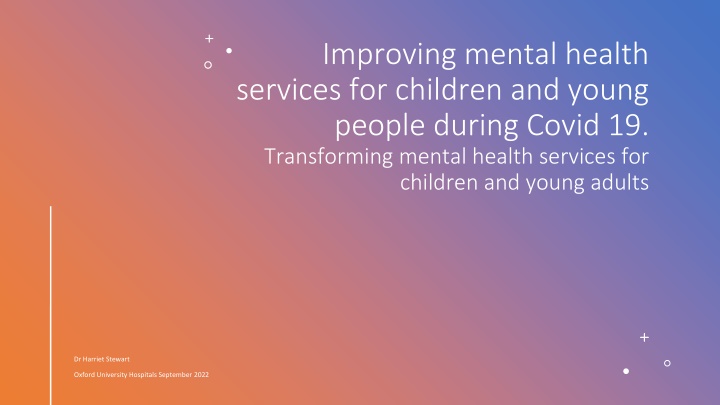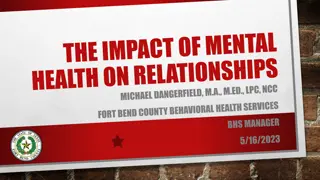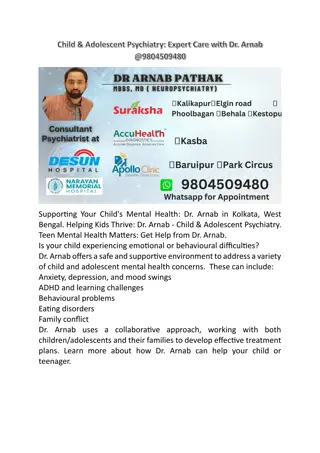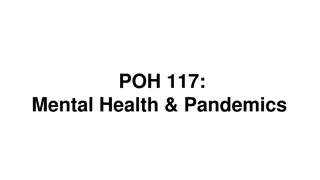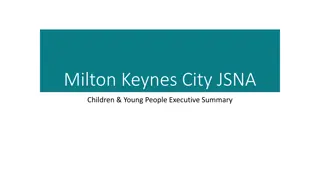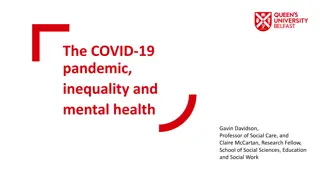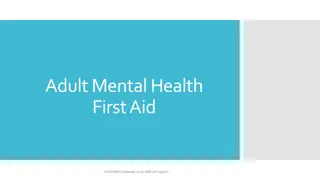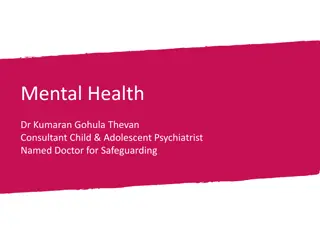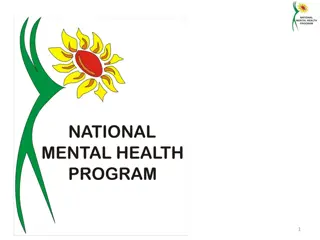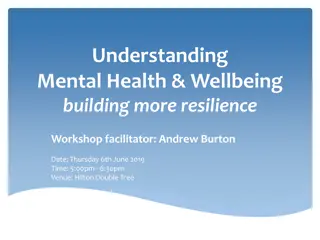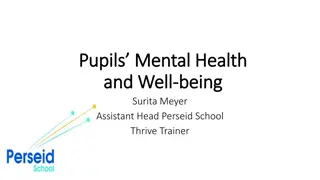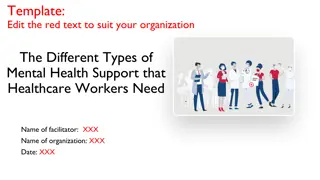Innovative Strategies for Enhancing Child Mental Health Services During Covid-19
Enhancing mental health services for children and young people during the pandemic is crucial. This includes improving early intervention, workforce development, and utilizing data for better outcomes. The impact of Covid-19 on children's mental health is evident, with fluctuations in referrals and an increase in complex cases. Challenges such as longer waiting lists and lack of specialist support need to be addressed to meet the evolving needs of children and families.
Download Presentation

Please find below an Image/Link to download the presentation.
The content on the website is provided AS IS for your information and personal use only. It may not be sold, licensed, or shared on other websites without obtaining consent from the author.If you encounter any issues during the download, it is possible that the publisher has removed the file from their server.
You are allowed to download the files provided on this website for personal or commercial use, subject to the condition that they are used lawfully. All files are the property of their respective owners.
The content on the website is provided AS IS for your information and personal use only. It may not be sold, licensed, or shared on other websites without obtaining consent from the author.
E N D
Presentation Transcript
Improving mental health services for children and young people during Covid 19. Transforming mental health services for children and young adults Dr Harriet Stewart Oxford University Hospitals September 2022
Improving mental health services for children and young people Early intervention and accessibility to CAMHS TRANSFORMATION AND INNOVATION POST-PANDEMIC Workforce development Role of data and outcome measures
PROPORTION OF CHILDREN WITH EMOTIONAL AND BEHAVIOURAL DISORDERS BY AGE GENDER AND DISORDER TYPE (CENSUS 2017)
Statistics (or what happened March 2019- 2022) Reduction in F2F patient care (Ougrin and Wong et al Pub 7 Mar 2022) Initial drop in referrals by over 50% Patients not attending A&E or GP surgeries Fear of catching covid or their parents catching covid Reduction in self-harm. More support at home/less anxiety re school and social life Similar pattern in USA (Penner et al 2021) and UK Chen et al 2020)
Then in Sept 2020 Sharp upturn in referrals- peak of 180% in Nov 2020 compared to previous years Ongoing demand has remained extremely high Huge environmental change for children
Increase in eating disorders and severity of presentation- eg requiring re-feeding in hospital:loss of control; loss of routine; pressure to exercise and social isolation. What are we seeing now? Increase in self-harm after the initial decrease seen in Mar 2021 Increase in anxiety across the board (initially some children said they felt less anxious in lockdown 2020). Now more OCD perhaps because of reduced exposure and avoidance during lockdown. It was the children without pre-existing MH problems and those with SEND who were found to have suffered most (gov.com). Conversion disorder is back.Tics (Heyman et al 2021) Increase in referrals of highly complex patients who are presenting extreme challenges within their home setting.
Waiting lists are getting longer Lack of early identification and diagnosis Lack of effective specialist support Children and families having brief assessment and intervention that is too superficial to meet their complex needs At the same time CAMHS clinicians and managers are also affected by the pandemic and suffering from exhaustion and burn-out Problems
Beth with tics Clinical examples Hayley with self- harm and autism
Online working Positives: Saving time for patients and clinicians Meetings Negatives Brain fog from online meetings Unable to see the whole patient Confidentiality
Research and QI projects and the ability to make a difference and make things work. Systems overhaul Leadership training Clinic coordinators to improve admin around appointments eg for NDT clinics so that they are one-stop as all the information has been gathered and discussed beforehand Inspiration with a common purpose and modelling to clinicians and CAMHS staff Senior assessment and allocation to treatment
ROLE OF DATA/OUTCOME MEASUREMENT National Data-Mental Health Service Data Set from Jan 2016 New ways of measuring- 5 year data plan Prevalence/incidence; access; quality; outcomes; prevention and spend Grouping CYP according to need-CCG Improvement and Assessment Framework Intervention codes and outcome tools-ratings RCADS; SDQ;CGAS;GOMS;DAWBA Annual updates-KPI s and payment outcomes- capitated and episodic year of care payment models
WORKFORCE Mental/physical health initiatives for staff with locally agreed uptake rates. Tackling bullying in the workplace. Line manager training in stress management Joy in work initiatives Headspace/mindfulness NHS health checks
Adapting CAMHS and meeting demand A more flexible attitude to work People moving in and out of the workplace and being able to change roles more easily Supporting workers to do their jobs rather than expecting them to meet targets Being healthy together- strength in teams Gratitude and helping others- vocational
References 1. Ougrin D, Wong BH, Vaezinejad M, Plener PL, Mehdi T, Romaniuk L, et al.Pandemic-related emergency psychiatric presentations for self-harm of children and adolescents in 10 countries (PREP-kids): a retrospective international cohort study. Eur Child Adolesc Psychiatry [Epub ahead of print] 7 Mar. Available from: 10.1007/s00787-021-01741-6. [PMC free article] [PubMed] [CrossRef] [Google Scholar] 2. McNicholas F, Kelleher I, Hedderman E, Lynch F, Healy E, Thornton T, et al.Referral patterns for specialist child and adolescent mental health services in the Republic of Ireland during the COVID-19 pandemic compared with 2019 and 2018. BJPsych Open 2021; 7: e91. [PMC free article] [PubMed] [Google Scholar] 3. Chen S, Jones PB, Underwood BR, Moore A, Bullmore ET, Banerjee S, et al.The early impact of COVID-19 on mental health and community physical health services and their patients mortality in Cambridgeshire and Peterborough, UK. J Psychiatr Res 2020; 131: 244 54. [PMC free article] [PubMed] [Google Scholar] 4. Penner F, Hernandez Ortiz J, Sharp C. Change in youth mental health during the COVID-19 pandemic in a majority hispanic/latinx US sample. J Am Acad Child Adolesc Psychiatry 2021; 60: 513 23. [PubMed] [Google Scholar] 5. Zhou SJ, Zhang LG, Wang LL, Guo ZC, Wang JQ, Chen JC, et al.Prevalence and socio-demographic correlates of psychological health problems in Chinese adolescents during the outbreak of COVID-19. Eur Child Adolesc Psychiatry 2020; 29: 749 58. [PMC free article] [PubMed] [Google Scholar]
Refs 2 6. Hawes MT, Szenczy AK, Klein DN, Hajcak G, Nelson BD. Increases in depression and anxiety symptoms in adolescents and young adults during the COVID-19 pandemic. Psychol Med [Epub ahead of print] 13 Jan 2021. Available from: 10.1017/s0033291720005358. [PMC free article] [PubMed] [CrossRef] [Google Scholar] 7. Khan AN, Bilek E, Tomlinson RC, Becker-Haimes EM. Treating social anxiety in an era of social distancing: adapting exposure therapy for youth during COVID-19. Cogn Behav Pract [Epub ahead of print] 5 Feb 2021. Available from: 10.1016/j.cbpra.2020.12.002. [PMC free article] 8. Odd D, Sleap V, Appleby L, Gunnell D, Luyt, K.Child Suicide Rates during the COVID-19 Pandemic in England: Real-time Surveillance. Healthcare Quality Improvement Partnership (HQIP), July 2020. 9. Branley-Bell D, Talbot CV. Exploring the impact of the COVID-19 pandemic and UK lockdown on individuals with experience of eating disorders. J Eat Disord 2020; 8: 44. [PMC free article] [PubMed] [Google Scholar] 10. Nissen JB, H jgaard D, Thomsen PH. The immediate effect of COVID-19 pandemic on children and adolescents with obsessive compulsive disorder. BMC Psychiatry 2020; 20: 511. [PMC free article] [PubMed] [Google Scholar] 11. Schwartz-Lifshitz M, Basel D, Lang C, Hertz-Palmor N, Dekel I, Zohar J, et al.Obsessive -compulsive symptoms severity among children and adolescents during COVID-19 first wave in Israel. J Obsessive Compuls Relat Disord 2021; 28: 100610. [PMC free article] [PubMed] [Google Scholar] 12. Heyman I, Liang H, Hedderly T. COVID-19 related increase in childhood tics and tic-like attacks. Arch Dis Child 2021; 106: 420 1. [PubMed] [Google Scholar] 13. Skripkauskaite S, Shum A, Pearcy S, McCall A, Waite P, Cresswell C. Report 11: changes in children s mental health symptoms from March 2020 to June 2021. 14. Dept of Education. The State of the Nation 2021: Children and Young People s Wellbeing 2022 15. ImpactEd. Lockdown Lessons Pupil Learning and Wellbeing during the Covid 19 Pandemic. (60000 pupils in England).
Thank you for listening
